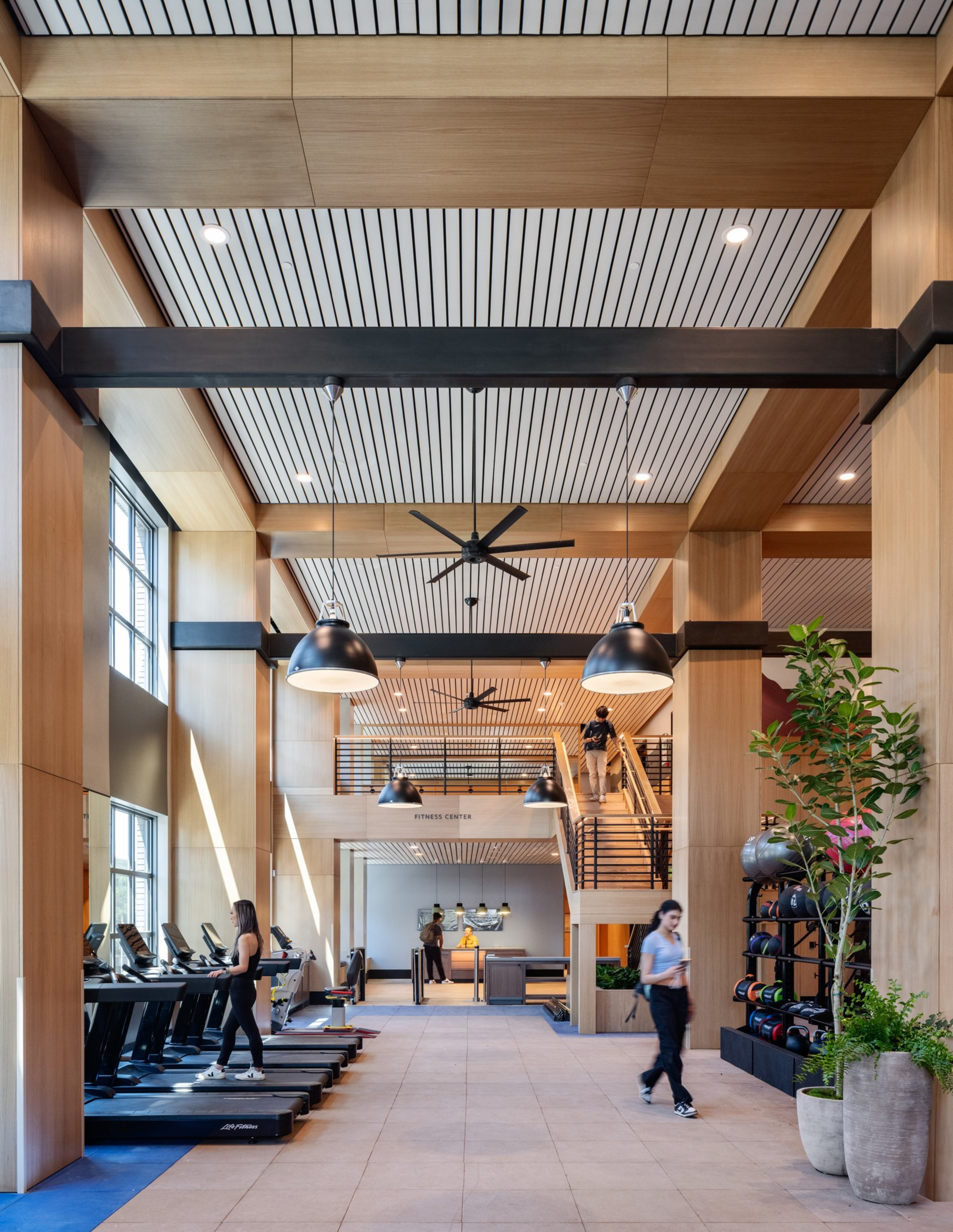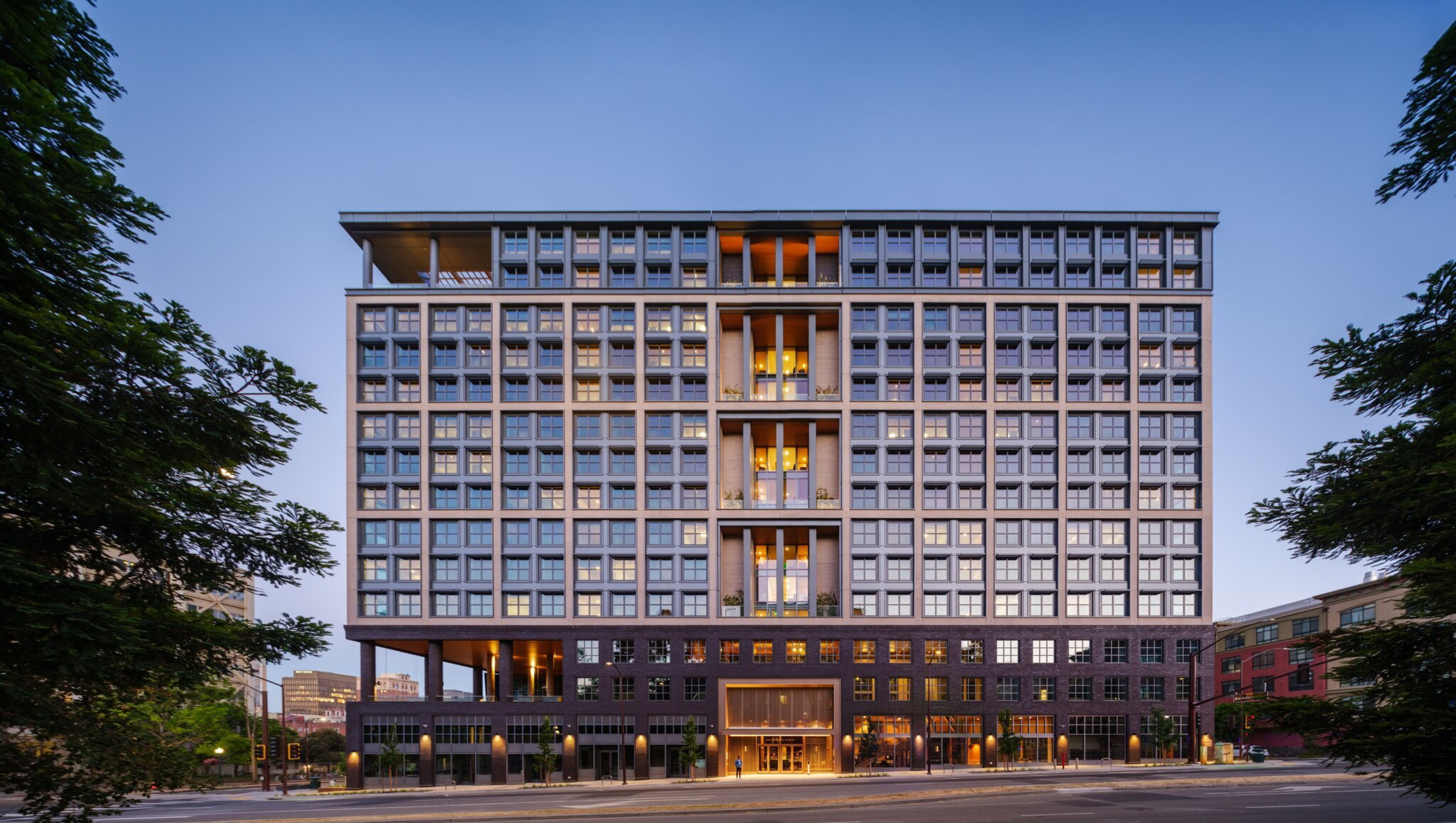When 772 UC Berkeley transfer students begin moving into the new Helen Diller Anchor House this week for the fall semester, they will enter a world of luxury that’s unheard of for the average college student.
And they will have one family to thank for the soaring, light-filled spaces, stairwells of oak and steel, and a central grassy courtyard flanked by two 120-foot-high living garden walls.
The Helen Diller Family Foundation and its intensely private scion, Jaclyn “Jackie” Safier, paid for the $300 million, 14-story complex without so much as a dime from UC Berkeley. The Diller family’s largess, the largest gift in the university’s 156-year history, is nothing new. Over the past 21 years, the foundation has donated $1.5 billion to the University of California, making it the largest contributor to the 10-campus system.
But students, faculty members, university activists, and even hip-hop artists (opens in new tab) have raised persistent questions about the family’s political values. Sure enough, a look at the family’s history of giving complicates an otherwise enthusiastic reception (opens in new tab) for the school’s most tricked-out new building.
At the heart of the controversy are the family’s business ties and support for right-wing Israeli causes. The family runs the Prometheus Real Estate Group, the largest private owner of apartment buildings in the Bay Area, and has long fought against progressives’ rent control initiatives throughout the state. Anchor House itself caused a stir when its construction displaced residents (opens in new tab) and led to the demolition of historic properties.
But the more contentious issue relates to the Diller Foundation’s contributions to right-wing Zionist organizations.


Controversial gifts
In 2016, the foundation, then directed by Safier’s late father, Sanford Diller, the son of Jewish immigrants, donated $100,000 to the nonprofit Central Fund for Israel. The gift included instructions to send the funds to Canary Mission, a shadowy online group that posts biographical information about students and professors whom the organization contends “promote hatred against the USA, Israel and Jews.” Dozens of UC students and professors are listed on the website.
“The dossiers are intended to hurt students’ job prospects, and have been used in interrogations by Israeli border officials,” according to The Forward (opens in new tab), which broke news of the donation in October 2018, eight months after Sanford’s death.
Also in 2016, the Diller Foundation funneled $125,000 through the Central Fund to Regavim, an Israeli group that files lawsuits to stop Palestinians from building homes in the West Bank, and to Reservists on Duty, a group that pays for Israeli soldiers to travel to U.S. colleges and speak out against the boycott, divestment, and sanctions movement. The foundation also made contributions to right-wing groups in the United States, including Project Veritas and the David Horowitz Freedom Center.
Safier, who rarely speaks to the press, waves away these past efforts by her family foundation and minimizes her connection to them. The 59-year-old, who lives in San Francisco and is CEO of the San Mateo-based Prometheus Realty Group, personally shepherded the Anchor House from its origins in a conversation with UC Berkeley administrators to its establishment as a very visible part of Berkeley’s downtown.

Safier is famously private; she has assiduously avoided the limelight and is averse to taking personal credit for her family’s public works. In fact, it took this reporter three years to get an interview with her, and even then, she declined to meet in person or walk through Anchor House together. Instead, she agreed to a 50-minute Zoom call from her office in San Mateo, not more than 40 miles away from where I was sitting at my home in Berkeley.
Finally, on a Thursday afternoon in late July, the elusive Safier appeared on the Zoom screen, accompanied by Phyllis Cook, a foundation officer and longtime philanthropic adviser to wealthy Bay Area families, and Larry Kamer, who works as the foundation’s communication strategist. Before we began our conversation, Cook made it clear Safier wouldn’t be doing other interviews after this procedure was over. “We’ve done a lot of buildings — no interviews,” she said.
With pleasantries out of the way, Safier began talking about Anchor House and how the foundation invests in large projects to make a large impact. She shied away from highlighting her role, reiterating that she was simply following her parents’ philanthropic wishes. This is what Safier is like, according to friends who asked not to be named: modest, down-to-earth, a regular woman who just happens to be the steward of a $2 billion corporation. (After the call, Kamer emailed to ask if he could “persuade” The Standard not to run a photo of Safier with the article.)


Safier’s disinclination to play a public role or to share information has not always worked in her favor so far as critics are concerned. Rather, it inevitably leads them to question her and her family’s motives and to criticize both the foundation and its university partners for a lack of transparency.
This spring, as protests against the war in Gaza erupted throughout the UC system, some objected to UC’s connection to the Diller Foundation. Demonstrators at UC Santa Cruz called for the school to sever its relationship with the foundation. Berkeley Law Students for Justice in Palestine, which led a weeks-long campus sit-in over the war in Gaza, had previously denounced a $10 million gift the Diller Foundation made to Cal’s Institute of Jewish Law and Israel Studies in 2021.
“This institute, housed at the law school, now gives the highest and most visible recognition to a group that champions Islamophobic hatred, misogyny and the suppression of political speech,” the group wrote in an editorial in The Daily Californian (opens in new tab), the student newspaper.
Jess Ghannam, a clinical professor of psychiatry and global health sciences in the School of Medicine at UCSF, published an opinion piece (opens in new tab) in May in UCSF’s newspaper stating that the Diller Foundation should be “condemned, not collaborated with.” Ghannam, a member of the Do No Harm Coalition (opens in new tab), has been pushing for UC to divest from Israel and call for a cease-fire in Gaza.
“The Diller Foundation has done some awesome things,” Ghannam told me. “The concerns I have do not have to do with these laudatory contributions. But because the dollar amount is so large and the Diller Foundation appears to have this complex relationship with funding what appears to be right-wing extremist elements within the pro-Israel community, we have questions, we have concerns. And because UCSF is a public institution, there should be more transparency.”
In our interview, I asked Safier if she condemned the controversial grants her foundation has made. Before she could respond, her reps shut down the question. “Respectfully, we are choosing not to comment on this,” said Kamer.
“There would be no statement that can be made in the world we live in now that would satisfy anybody anyway,” added Cook. She pointed out that the donations to right-wing Israeli causes were a small fraction of the billions the Diller Foundation has given to organizations in the arts, science, public health, and education.
Safier did, however, talk about the controversial grants in an interview with Inside Philanthropy (opens in new tab) in 2019. She said they were “motivated by concern about anti-Semitism” but admitted the tactics of Canary Mission and Regavim “are not OK. We are absolutely staying away. I know politics are part of life, but I’m staying away.”


Birth of a real estate empire
Like Safier, her father, Sanford, disliked being in the public eye. “He would not allow his name on anything,” said Cook. When the Dillers created the foundation in 1999, it was named after Safier’s mother, Helen, who was more outgoing. She died in 2015.
Helen’s name can be found on plaques, galleries and buildings all over San Francisco: Thousands of children have enjoyed Helen Diller playgrounds in Dolores Park, the Civic Center, and Presidio Wall Park. Visitors to the de Young Museum have walked through the Diller Entry Court; Golden Gate University students have taken advantage of the Helen Diller Center for Veterans of U.S. Military Service. The foundation has also given major grants to the San Francisco Museum of Modern Art and the Legion of Honor.
Helen and Sanford Diller, the first in their families to attend college, met in 1950 at a dance at UC Berkeley. In honor of that occasion, Anchor House’s address is 1950 Oxford St. They married in 1951 and eventually moved to Los Altos, where they raised three children: Ron, Brad and Jaclyn. The two brothers are not involved with the real estate business or the foundation. Safier and Ron, who lives in Israel, have been embroiled in a six-year inheritance fight over the Dillers’ complicated estate, including a trust that holds Prometheus Real Estate. (Brad is not a party to the lawsuit.)

After attending Mountain View High School, Safier went to Tufts and Harvard Business School. She joined Prometheus in 1992, when she was 29. In 2010, she took over as president. In 2015, she became CEO.
The private company, which Forbes valued at $2.3 billion in 2014, oversees a vast real estate portfolio that includes more than 2 million square feet of commercial space, 55 residential complexes, and 13,000 luxury apartments around the Bay Area. It also has extensive holdings in Seattle and Portland. It has won dozens of design awards. A portion of its revenues fund the foundation. Its trademark is “Good Living for the Greater Good.”
But Prometheus drew criticism in 2016, when it donated funds to oppose a local rent-control measure in Mountain View, where it is the biggest apartment owner and landlord. Prometheus also helped bankroll efforts to defeat two statewide measures to expand rent control, contributing $3 million since 2018, according to campaign filings. “Safier has a sordid history when it comes to rent control,” according to the site Housing Is a Human Right (opens in new tab). Prometheus also declines to use union labor, according to Lenny Siegel, the former mayor of Mountain View, where the company has operated thousands of apartments.


Like the company she runs, Safier’s personal politics, as seen through her financial gifts, are a mix of conservative and liberal. She is a registered independent, according to San Francisco voter records. In 2016, Safier scattered $10,000 donations to state Republican parties in Wisconsin, Michigan, Ohio, Virginia, Florida, New Hampshire, Illinois, North Carolina, and Missouri, according to campaign finance records. She also gave $133,600 to the Republican National Committee.
Yet Safier and her husband, Dan Safier, are also donors to big-name Democrats, giving five-figure gifts to Gov. Gavin Newsom, Kamala Harris, Joe Biden, Stacey Abrams and the Democratic National Committee.
“Politics isn’t really her thing, and she’s more interested in the candidate than the party when she does pay attention,” said a political consultant with knowledge of Safier’s operations. “She’s not beholden to any party.”
‘Keep it positive’
While she may be disinterested in politics, Safier is obsessed with buildings, according to those who know her. She has a refined aesthetic, honed through the development of thousands of luxury apartments, that she applied to the construction of the new dorm — Cal’s first privately funded student housing in 79 years. She chose top architects Morris Adjmi and BDE Architecture to implement her vision for a dorm that would enhance transfer students’ feelings of belonging.
Before design work even started, the Prometheus team and Cal officials came up with a novel idea to put the building to work for the students. Since the construction did not cost UC Berkeley anything, there is no debt to repay. Revenue from operations, about $4.5 million a year, will go into a fund that will provide about 400 two-year scholarships for low-income students, according to the university.

Construction began during the pandemic, but only after an ugly battle in which the university razed a 112-year-old rent-controlled building, evicting 12 people. Anchor House was built in one and a half years — record time by Bay Area standards.
An executive at Prometheus boasted that Safier personally reviewed many of the finishes in the building. High standards are so important to her that she outlined in the gift agreement with UC Berkeley how the building must be maintained and how staff should interact with students. In addition to suggesting the best methods and frequency of cleaning common areas, the agreement instructs staff how to answer the phone, among other commands. “Keep it positive — Callers can hear an upbeat attitude in your voice,” the agreement reads. Emails should be answered “within 24 business hours whenever possible. Do not write in CAPITALS, this is the electronic version of shouting.”
All of this polish is consistent with the building itself, which is unequivocally nice. Students will sleep in suites with custom furniture, large windows, a living room, a kitchen, and a built-in washer and dryer. They can exercise in a private fitness center with an indoor-outdoor yoga space or hang out on swinging patio chairs on a terrace overlooking campus. High-end materials are everywhere, including in a room lined with wood paneling from an ancient sequoia.
“Anchor House is truly exceptional and is the best student housing I’ve ever seen,” former chancellor Carol T. Christ, who championed the project, told UC Berkeley News (opens in new tab). UC’s soon-to-be-former president, Michael Drake, told The Standard that “it’s wonderful to see Jackie Safier continue the philanthropic legacy of her parents, Sanford and Helen Diller, who met while attending UC Berkeley.” He credited the family with being “incredible supporters of the University of California, donating to numerous efforts over more than two decades. Donors like this helped make the University of California what it is today.”
During our interview, however, Safier was more understated about her contributions. “We wanted to do it well, and we wanted to make a building of high quality,” she said simply.
This is how Safier operates: inconspicuously. The name might not be recognizable, but all over the Bay Area, we’re walking in its shadow.
